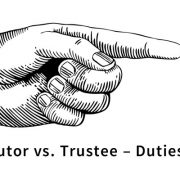Ohio Revocable Living Trusts
What is a revocable trust?
Revocable trusts, commonly referred to as revocable living trusts, can be changed or terminated during a person’s lifetime as long as they are competent. The creator of the trust, referred to as a “grantor” is usually the initial trustee and maintains full control over the assets placed in the trust. A successor trustee is named to manage the trust assets if the grantor becomes incapacitated or passes away.
This type of trust is attractive because you can update your beneficiaries, change which assets are included in the trust, and update how assets will be distributed.
Revocable trusts avoid probate and allow you to maintain privacy. In addition to saving time and money associated with the probate process, you can protect your family’s documents from becoming part of public record.
Revocable Trusts vs. Irrevocable Trusts
Upon death, a revocable trust becomes an irrevocable trust and cannot be changed. At this point, the successor trustee must follow the instructions in the trust document to distribute the trust’s assets.
Learn more about the key similarities and differences of revocable and irrevocable trusts here.
Revocable Trusts vs. Testamentary Trusts
Revocable trusts are funded during the grantor’s lifetime, while testamentary trusts are funded after the death of a testator, or creator of a will.
Testamentary trusts are also called will trusts because they are created inside a will and do not take effect until you pass. Unlike a revocable trust, this type of trust will go through probate costing you time, money and your privacy.
Why should I set up a revocable trust?
A revocable trust can:
- Avoid probate court and provide an efficient, seamless transfer of assets to beneficiaries
- Protect your children’s inheritance if your spouse remarries after divorce or death
- Protect the money and assets left to your beneficiaries from claims of their creditors or litigation
- Protect the inheritance and government benefits of children with special needs
- Make it easier to distribute specialty assets, such as real estate or artwork, to beneficiaries
More Specific Types of Revocable Trusts & How They Work
Joint Trusts
Joint trusts are often utilized by married couples to cover joint or individual assets and to specify what happens upon the death of each spouse. Typically, when the first spouse passes, the living spouse becomes the trustee and gains control over the trust. Then, when the surviving spouse passes, a successor trustee takes over management and distributions.
Bloodline Trusts
Bloodline trusts are created to ensure that spouses of intended heirs do not inherit in the event of divorce or death. Instead, if a child passes or divorces, their children (i.e. your grandchildren) would become the beneficiary.
Special Needs Trusts
Parents or grandparents of a disabled child can establish a special needs trust as part of their estate plan. This type of trust helps protect private funds for the disabled loved one without putting their eligibility for government-offered benefits at risk. There are three main types of special needs trusts:
- Third-Party: A third-party sets up and funds the trust
- Pooled: Managed by a non-profit organization
- Self-Settled: The disabled beneficiary sets up and funds the trust
How To Set Up A Revocable Trust With An Attorney
It’s important to remember that a revocable trust is just one part of a comprehensive estate plan. For example, in many cases, a revocable living trust is created alongside a pour over will. The pour over will is designed to work together with your living trust, and acts as a backup plan to ensure all of your assets are directed into your trust.
After it has been determined that a revocable living trust should be part of your estate plan, an attorney can walk you through these key steps:
- Decide what assets will be placed in your trust. While you might already have an idea of what you’d like to include, your attorney may help you uncover some additional assets that would benefit from being placed in a trust. Assets can range from cash and investments to real estate and other property.
- Choose your beneficiaries. They might include your spouse, your children, grandchildren or other close family members.
- Establish the rules of your trust. For example, will assets be distributed with age requirements or terms for how the assets may be used?
- Determine who will manage the trust if you are not competent or once you have passed.
Once you are confident in these decisions, your estate planning attorney can draft the trust document and begin assisting you with funding the trust.
This blog is for educational purposes only; it is not intended to provide legal advice. If you’re planning for your estate and want to speak with an attorney, call 216-573-3723.











